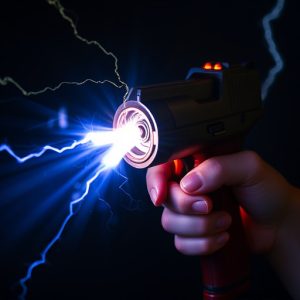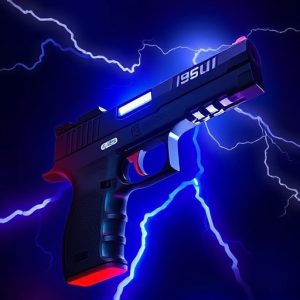Decoding Stun Gun Voltage: A Guide to Their Effectiveness
Stun guns deliver an electric shock to incapacitate an attacker, and while their advertised voltage…….
Stun guns deliver an electric shock to incapacitate an attacker, and while their advertised voltage can be impressive—ranging from 50,000 to over 1 million volts—it's not the sole determinant of effectiveness. The real key factors are the device's amperage, battery longevity, and the design of its electrical output system, which collectively affect how well it works in real-life self-defense situations. Is voltage important for stun guns? It is a part of their functionality, but it must be considered alongside current (measured in amperes) and other design aspects to ensure the stun gun is both effective and safe. High voltage alone does not guarantee efficacy; a lower-voltage, higher-current stun gun can be equally effective. Users should focus on the combined output of voltage and current, along with the pulse delivery system, to select a stun gun that will provide reliable defense without causing harm. Therefore, while voltage ratings are often marketed, they should not overshadow the importance of amperage and pulse delivery system design for practical use in self-defense scenarios.
When it comes to personal safety devices, stun guns often raise questions about their effectiveness, particularly concerning the voltage they display. This article delves into the critical role voltage plays in the performance of stun guns, demystifying myths and confirming facts. We’ll explore how voltage is both a defining feature and a key indicator of stun gun models’ capabilities. Understanding the relationship between voltage and stun gun effectiveness is essential for those considering these devices for self-defense. Join us as we investigate the science behind stun guns, compare their voltage ratings against real-world performance, and clarify why voltage is important in this realm of personal protection technology.
Understanding Stun Guns and Their Displayed Voltage: A Closer Look
Stun guns, also known as electric stun devices or electroshock weapons, are designed to incapacitate an attacker by delivering a high-voltage, low-current electrical shock. The effectiveness of a stun gun is often associated with its voltage output. Understanding the role of voltage in stun guns is crucial for users to make informed decisions about which device to choose for personal defense. Typical stun guns can range from as low as 650,000 volts up to 1 million volts or more. While higher voltage might seem inherently better, it’s important to consider how this voltage is applied and the resulting current for safety and effectiveness. The actual impact of a stun gun’s voltage depends on various factors, including battery strength, circuit design, and the distance between the probes and the target.
The importance of voltage in stun guns lies not just in its capacity to generate shock but also in its ability to deliver a sufficient, incapacitating level of power without causing serious harm. Users should be aware that the displayed voltage on a stun gun does not directly equate to the strength or effectiveness of the device. Instead, it’s the interaction between the electrical output and the human body’s response that determines the effectiveness of the stun gun. Manufacturers may advertise high voltages to appeal to consumers, but users should look beyond the voltage specification and consider other critical factors such as amperage, battery life, and ease of use when selecting a stun gun for self-defense purposes. Understanding these aspects ensures that individuals choose a device that is both effective for protection and safe for both the user and the potential assailant.
The Role of Voltage in Stun Gun Effectiveness: Myths and Facts
Stun guns are designed to incapacitate an assailant by delivering a high-voltage, low-ampere electric shock. The effectiveness of a stun gun is often attributed to its voltage output, with higher voltages generally assumed to be more effective. However, it’s not just the voltage that determines a stun gun’s stopping power; the current (in amperes) also plays a crucial role. A higher voltage can increase the range at which the device can effectively deliver a shock, but it must be paired with an adequate level of current to ensure the electrical charge is strong enough to penetrate the target’s clothing and skin, causing muscle contractions that render the attacker immobile.
Contrary to some myths, voltage alone does not dictate the efficacy of a stun gun. For instance, a device with a lower voltage might still be effective if it delivers a higher current, which can be more disruptive and harder for an assailant to endure than a high-voltage, low-current shock. Moreover, the design of electrode configurations significantly impacts how well the electrical charge will incapacitate a person. Manufacturers often optimize both voltage and current, as well as the electrodes’ placement and shape, to maximize the stun gun’s effectiveness. It’s important for users to understand that when considering stun guns for self-defense, looking at the combined output of voltage and current, rather than just voltage, will provide a clearer picture of potential effectiveness.
How Stun Guns Generate Electricity and the Importance of Voltage Readings
Stun guns are self-defense devices that incapacitate an attacker by delivering a high-voltage, low-amp electrical charge. The functionality of a stun gun is rooted in its ability to harness electricity; it typically contains two conductive probes separated by a distance. When activated, a battery within the device drives current through the probes, creating an electric field between them. This field ionizes the air and allows the electrical charge to jump the gap, delivering a powerful shock to any person or object touching both probes. The intensity of this shock is largely determined by the voltage present; higher voltages can lead to stronger muscle contractions and a more effective stun.
The importance of voltage in stun guns cannot be overstated. Voltage plays a critical role in the effectiveness of the device. A stun gun with a lower voltage may not deliver an adequate shock to incapacitate an attacker, while one with too high a voltage could potentially cause harm beyond self-defense. Therefore, when evaluating or using a stun gun, understanding the voltage output is essential. It ensures that users can defend themselves effectively and legally, as local laws often dictate permissible voltage levels for such devices. Manufacturers typically specify the voltage on their products; for instance, many legal stun guns operate at around 50,000 to 100,000 volts. However, the actual voltage experienced by an attacker is significantly less due to the resistance of their body and the design of the device, which includes safety features to prevent misuse. Users should always refer to the manufacturer’s guidelines and comply with local laws regarding stun gun usage, ensuring they are well-informed about the voltage and capabilities of their self-defense tools.
Comparing Stun Gun Models: Voltage Ratings and Real-World Performance
When evaluating stun gun models, understanding the voltage ratings is crucial for assessing their potential effectiveness and safety. Stun guns are designed to incapacitate by delivering a high-voltage electric shock that disrupts muscle control in the target subject. The voltage rating of a stun gun is indicative of the amount of electrical power it can deliver. While manufacturers often list voltage ratings, which can range from as low as 60,000 volts to over 1 million volts, these figures represent peak values and are not reflective of sustained output. Therefore, potential users should consider how these high voltages translate into real-world performance.
In practice, the actual voltage a stun gun delivers during use can differ significantly from its rated voltage due to factors like battery strength, circuit design, and the build of the electrodes. For instance, a unit with a 950,000-volt rating might not maintain that level throughout deployment. Instead, users should focus on how the stun gun performs in actual self-defense scenarios. Factors such as amperage (measured in milliamperes), which determines the strength of the electric shock, and the design of the device’s electropulse delivery system, are more critical indicators of a stun gun’s efficacy. Users should look for models with higher amperage outputs and well-designed pulse delivery systems to ensure reliable performance when faced with an adversary. Understanding is voltage important for stun guns lies in recognizing that while voltage ratings are a selling point, the true measure of a stun gun’s effectiveness is its ability to deliver a powerful and incapacitating shock under the varying conditions it might encounter during use.


